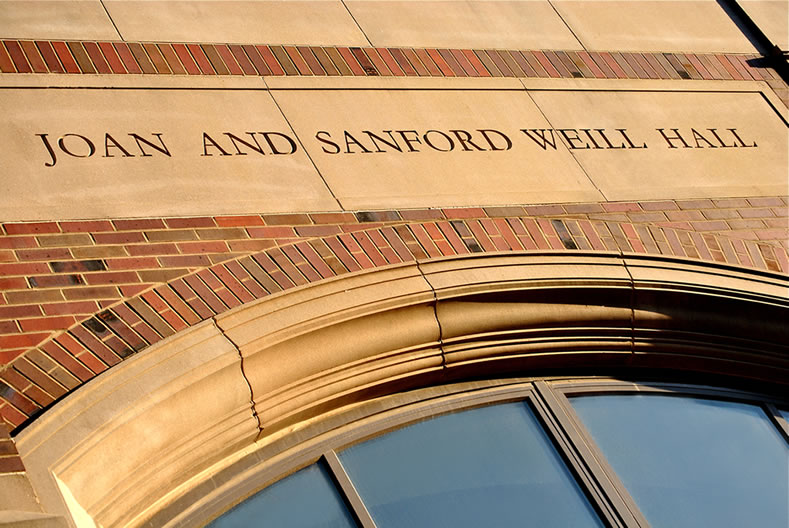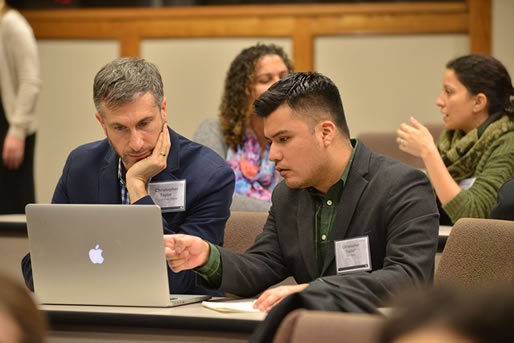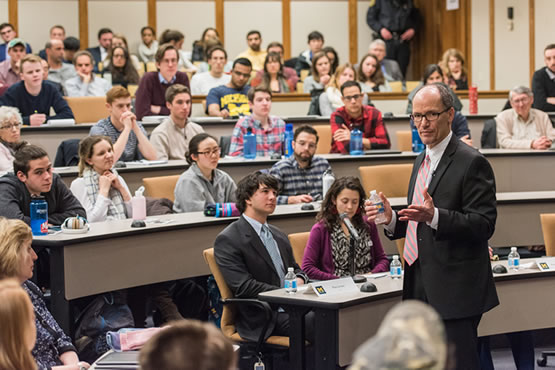First there was Angell Hall, then the Law Building, Haven Hall, Rackham, and Lorch. And for the faculty and staff who couldn't be shoehorned into those facilities, there was the Gunn Building, then the "annexes" at Huron and Oakland.
Jennifer Niggemeier, director of graduate career services and alumni relations, remembers "the annex exile" at Huron well. "Becky [Blank] referred to it as the Ford School physical fitness program," she says.
|
|
Later, Niggemeier's office was moved to the Oakland Annex—a bit closer than the Huron Annex, but a site she continues to refer to as "a pit of despair." [When they tore down the building, the construction crew allowed faculty and staff to pitch rocks through the windows. Niggemeier keeps a brick as a memento.]
But when the school was renamed in honor of President Gerald R. Ford, more than five-dozen donors—many of them friends of President and Mrs. Ford—contributed close to $15 million toward construction of a new home for policy studies. The lead gift? From Joan and Sanford Weill.
"There isn't a day that goes by when we don't think about President and Mrs. Ford and the wonderful relationship we had with them," says Sanford.
"They epitomized hard work, humility, and leadership in every facet of their lives. President Ford was never afraid of making a tough decision, even if it was unpopular at the time, and the courage and strength Mrs. Ford displayed openly to the world as she battled addiction was unprecedented and positively changed countless lives forever."
|
|
"It's been ten years since Weill Hall was completed putting us, quite literally, on the map," says Susan M. Collins, the Joan and Sanford Weill Dean of Public Policy. "It's a beautiful facility, and a home, that's become an irreplaceable asset to our community."
In honor of that anniversary, here are ten things—some serious, some fun—that the building has made possible.
1. Growth
|
|
In 2006, 72 students graduated from the Ford School. In 2016, 174 students—including MPA, MPP, PhD, and BA students—walked the stage.
2. And rest
We don't have any cots (yet), but every now and then you'll catch a student napping on one of the building's comfy couches.
3. Practice
In our annual Integrated Policy Exercise, more than 100 students play stakeholders while tackling a time-limited policy challenge.
4. And pics
Students love to pose for photos in the Great Hall.
5. Alumni in residence
Close to two dozen Ford School alumni visited last year, offering career guidance to students in search of internships, jobs, and advice.
6. And puppies in residence
We admit it. We love to haul out the carpets and host puppy play therapy during finals.
7. Job interviews
When recruiters call, or increasingly Skype, there's a quiet space for student interviews.
8. And paper cranes
Our students made cranes to advertise last year's class gift campaign, which created an emergency fund for students facing financial hardship.
|
|
9. Talks
Last year alone, we hosted 93 events in the building, including 19 Policy Talks @ the Ford School that attracted more than 2,658 guests.
10. And more talks
Our facilities manager, Bill Kelly, reports receiving 2,336 room requests for small group meetings in our conference and class rooms. That's in addition to the 147 courses held in those classrooms for our 395 bachelor's, master's and doctoral students.
We could go on and on, about the art, the views, the visibility, and the magazine title (our location at the southwest gateway to campus—the corner of State & Hill Streets—seemed just right), but we'll end with a simple "thank you" to the donors who helped build this home, and to the faculty, staff, and students who have brought it to life.
Below is a formatted version of this article from State & Hill, the magazine of the Ford School. View the entire Fall 2016 State & Hill here.




